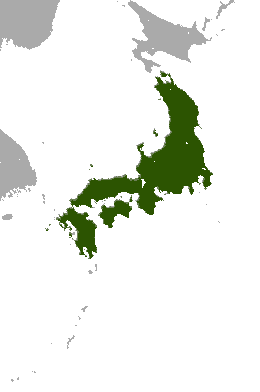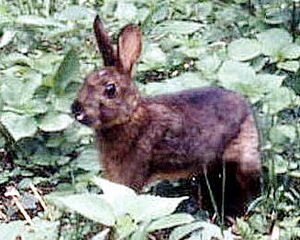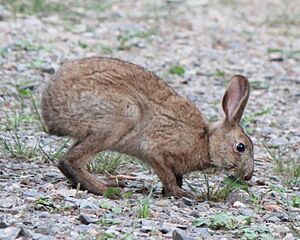Japanese hare facts for kids
Quick facts for kids Japanese hare |
|
|---|---|
 |
|
| in March, in a park in Tsukuba, Japan | |
| Conservation status | |
| Scientific classification | |
| Genus: |
Lepus
|
| Species: |
brachyurus
|
 |
|
| Japanese hare range | |
The Japanese hare (Lepus brachyurus) is a type of hare found only in Japan. In Japanese, it's called Nousagi, which means "field rabbit." These hares are known for their ability to change fur color in winter.
Contents
About the Japanese Hare
The Japanese hare was first described by a scientist named Coenraad Jacob Temminck in 1845. Its scientific name, brachyurus, comes from ancient Greek words. Brachys means "short," and oura means "tail." This name describes the hare's short tail.
Types of Japanese Hares
There are four different types, or subspecies, of the Japanese hare:
- L. b. angustidens
- L. b. brachyurus
- L. b. lyoni
- L. b. okiensis
What Do Japanese Hares Look Like?
Japanese hares are reddish-brown in color. They are about 45 to 54 cm (18 to 21 in) long, which is about the length of a ruler and a half. They weigh between 1.3 to 2.5 kg (2.9 to 5.5 lb), similar to a small house cat.
Their front legs are about 10 to 15 cm (3.9 to 5.9 in) long. Their back legs are a bit longer, from 12 to 15 cm (4.7 to 5.9 in). Their ears can grow to be 6 to 8 cm (2.4 to 3.1 in) long. Their short tails are only 2 to 5 cm (0.79 to 1.97 in) long.
Winter Fur Color
In some parts of Japan, like the northern areas and the island of Sado, it snows a lot. In these places, the Japanese hare changes its fur color. In autumn, its reddish-brown fur turns white. It stays white all winter, helping it hide in the snow. When spring arrives, its reddish-brown fur grows back.
Where Do Japanese Hares Live?
Japanese hares live on the main islands of Japan: Honshu, Shikoku, and Kyushu. They are not found on Hokkaido island. On Hokkaido, you'll find a different type of hare called the mountain hare.
These hares can live in many different places. They are often found in mountains or hilly areas. They also make their homes in forests or bushy places.
Living Near People
Japanese hares are very good at adapting to new environments. They have learned to live in and around cities and towns. Sometimes, they even become a bit of a problem in urban areas because there are so many of them.
Japanese Hare Life Cycle
Japanese hares can have between 1 and 6 babies in one group, called a litter. It's not fully known how old they are when they can start having babies. However, female hares probably start breeding within a year after they are born.
Breeding Habits
Hares can have babies all year long. They usually have several litters each year. Each litter typically has 2 to 4 young hares. When it's time to find a mate, male hares will chase females. They might even "box" with other males to scare them away.
How Japanese Hares Behave
Like most hares and rabbits, the Japanese hare is crepuscular. This means they are most active and feed mainly during the evening and early morning hours. During the day, they usually rest.
Japanese hares are usually quiet animals. They only make a sound if they are in danger or distress. Sometimes, they might even use burrows for shelter.
Social Life
For most of the year, the Japanese hare is a solitary animal. This means they prefer to be alone. However, during the mating season, males and females will gather together to breed.
What Do Japanese Hares Eat?
Japanese hares get most of their food from the plants around them. They eat many different types of vegetation. This includes grasses, shrubs, and bushes.
Eating Tree Bark
The Japanese hare is one of the few hares that will eat the bark off of trees. They do this sometimes, which can cause a lot of damage to trees and forests. They have even been known to eat the bark from bonsai trees in Asia.
Protecting Japanese Hares
The number of Japanese hares seems to be steady. However, the places where they live are getting smaller or changing. People sometimes hunt them or collect them for study.
Threats to Hares
Japanese hares face several threats. These include:
- New urban and industrial areas being built
- Water systems like dams that change their habitat
- Hunting and trapping by humans
- Diseases and new species that are not native to Japan
It is not known if Japanese hares live in any protected areas.
Hares and People
In some places, the Japanese hare has become a nuisance animal because there are so many of them. People hunt them in certain areas for food, fur, and to help control their population.
Hare in Mythology
The Japanese hare also appears in old stories. The mythic Hare of Inaba is an important part of the legend of the Shinto god Ōkuninushi.




